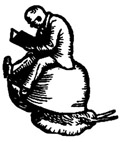Standing Stone Saraswati, Twelfth Century, Deccan
Victim of a faith that will never understand her,
Defaced, mastectomised, her many arms mutilated,
Then left to lie at the bottom of a pond for centuries,
She is now object who once was divine—
Her face flattened featureless,
Her stone lute lost, her right leg a cleft,
Bare ridges of quarried rock where garlanded breasts
Once brazenly hung.
No sign remains here now, upon the cratered waist and torso,
Or amidst these tides of bruised rock, round chunks of shoulder,
Shards of a bracelet, shreds of an elaborate girdle,
To remind us that this indeed is she
Who once was revered with flowers and song.
Now only the peacock at her feet survives intact,
To tell us afresh of her erstwhile power,
Its form complete, its frame unharmed from crest to tail,
Its open beak and intricately detailed plumage
Believed perhaps—unlike the lost features and breasts
Of the goddess herself—neither heathen nor offensive enough,
To merit the marauder’s triumphant tribal rage;
The little claws and long tail, the proud feathered chest
And slender upturned neck,
No serious threat to the invader’s abstract monolithic order,
Unworthy of his victorious descending axe.
Waterhole
Something in the blood wants to leap,
Here, outside the ICU my father’s in,
His speech now taken from him,
By bandages, tubes and pipes.
What wants to leap is like the sound and stroke
Of a bright steel plectrum against a taut tuned string,
The hollow russet gourd with its bridge of horn
Leaf-decked and lacquered in Calcutta in his early teens,
Reverberating with the tiles of a mosaic floor,
Laid down at his grandfather’s behest to allure the dead—
An untameable sound, febrile, metallic,
That reaches out not for perfection of pitch or form,
But for the undergrowth of forests visited in solitude,
Between sessions at court or five-star hotels.
It is a music that summons the jungle home,
Beseeching it to inhabit the domain of time-hallowed metres,
And arched, ancestral walls, once believed indomitable;
Each creepered phrase, each verdurous pause,
Urging it to confer, on territories of tone
That have stood like temples,
Its uncontrollable strength.
What longs to leap is impassioned
As the sound of strings he tuned and strummed,
Pulled, plucked and put aside for years;
But also, it is as tuneless, aloof and swift,
As the single click of a black-and-white camera,
Heard, against the torrid crunch
Of desiccated leaf-beds crumpled by hooves,
Amidst crane-squawk, deer-bark, cricket-hum and baboon-hoot,
In the parched interior of a landlocked forest
Towards the end of March,
When trees turn skeletal, and all streams for miles around
Run dry, all pools but this one—
His breath slowing down,
As he turns from the lens to the thought of thirst,
And rows of antlers sail cautiously into view,
Till it is time to gather with those who have gathered,
Receiving what deer and buffalo receive,
Asking to live, here only for water.
Man and Woman Gazing at the Moon
(Friedrich, c.1830)
Something about these leafless branches,
These twisted roots heaped with moss;
Or the distant green of drooping pines
At the edge of a ridge, now renews in the eye
A tenuous reverence for lavender evenings.
To look on from here,
Is to know one must remain outside,
Acquiescing to the unknowable,
Conceding to the power of the unalterably unseen:
Man and woman gazing at the moon—
Their faces, because never painted, forever invisible—
Here seen from behind as nothing more
Than a wide black cloak and hat,
A tenebrous gown,
Green yielding to strains of salmon-pink and purple,
The moss beneath thickening.
|

